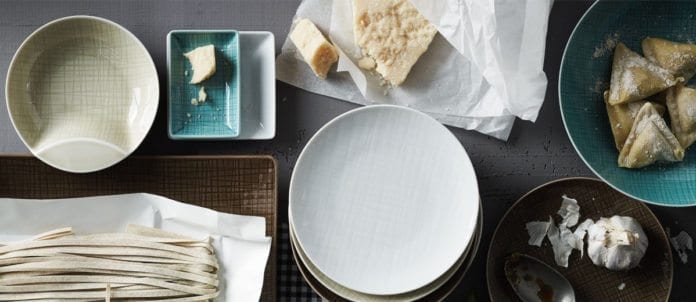For restaurateurs and foodservice operators, thereÕs a distinct reason for using certain dinnerware and cutlery. Whether the focus is on function, form, style or substance, there are plenty of available options. For Geoffrey Morden, executive chef at the Shaw Centre in Ottawa, those choices are all about consistency, quality and supply. That’s especially important on days when the conference facility may need to serve up to 4,000 meals in a sitting.
The dinnerware choice is a simple, sturdy white design from U.K.-based Steelite that can handle day-to-day usage and is easily replenished. “Colours may be in vogue now, but in two or three years they may not be, Morden says. “Turnover can get very costly, so it’s often better for operations like ours to stick with more standard designs. Sure, we would love to pick more contemporary upscale stuff, but the reality is we have to take other factors into consideration.
One of those factors is that the kitchen runs a sizeable Rational cook/chill finish operation, which means plates have to be the right dimensions to maximize the space on racks. Another is plate covers. “I’d say 90 per cent of the meals we serve need to be lidded and stacked before they are run out. While it would be nice to have square or rectangular plates, manufacturing a custom lid would cost four to five times a standard stainless steel one, Morden notes.
Flatware is a simple contemporary modern design by New York-based Oneida chosen for its clean look and weight. “When choosing cutlery, we have to think about the weight and what that means if servers have to walk long distances. Also, the finish is important. Plated silver might be fine for higher-end hotels, but stainless steel is much less work.
When choosing suppliers, Morden looks for a good track record of reliability that can consistently provide replacements and has a portfolio that can take care of all Shaw Centre’s needs, from cups and saucers to signature pieces for buffets.
At Scaddabush, colour and variety are the drivers behind the concept’s rustic Italian theme, says Mike Cappiello, VP, Alice Fazooli’s, Scaddabush for SIR Corp. in Burlington, Ont. With three locations and plans for four more in the coming months (two Alice Fazooli’s conversions and two new sites), he says the new dinnerware and cutlery fits in with the resurgence in Italian-style, homemade, premium food. “We’re striving for the most Italian kitchen-type with our smallwares, Cappiello explains. “So we have a mish-mash of generously sized plates, bowls and side plates that suits a non-linear, non-structured atmosphere. Not everything matches but it’s all indicative of what you would find in a traditional Italian kitchen.
Going the multi-colour, multi-shape route may come at a slight premium, he says. “But the rustic category is growing so there’s a lot more to choose from and it’s a lot more affordable than it was. It’s not as cheap as white, but [the premium] is not enough to be a detriment to our profit model.
Whether it’s classic white for a high-volume operation or home kitchen-style smallwares in a more intimate restaurant setting, Bill Horosko, president of Tableware Solutions in Mississauga, Ont. says restaurateurs should think about consistency and availability of immediate supply when determining what fits best for their environment.
Plain, white ceramic that is simple and ergonomically designed has long dominated basic choices, with some chefs opting for value-added features such as surface designs, unusual shapes and embossments. Heat retention is often a consideration as well. “Chefs want the confidence that the dishes they choose can keep the presentation consistent no matter how far the table is from the kitchen, Horosko says.
A parallel trend gaining ground these days is the “cottage industry-type movement that features varied colours as well as complementary materials such as stainless steel and wood. The hottest trends in recent months is charcuterie boards and sharing platters and vessels, he reports.
As a much longer term investment, the main factors for choosing cutlery are weight and balance, Horosko explains. “Whatever the composition, it should be properly balanced all the way through so they are comfortable and functional. These features matter to consumers and can make a huge difference. Stainless steel is the option of choice for mainstream demands, while a new and unique offering on the cutlery horizon is PVD (physical vapour deposition) coatings, with finishes ranging from copper and gold to black, which are comparable to silver plates in pricing.
Whatever the budget or theme however, Horosko says choices ultimately boil down to one principle. “Everybody wants the highest perceived value they can get.
Volume 48, Number 2
Written By: Denise Deveau


















